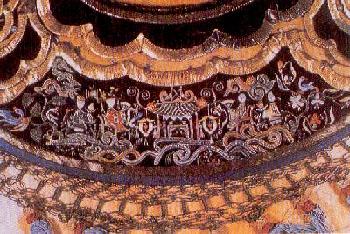|
Clothes of Chinese ethnic minorities are flowery and colorful, extremely exquisite, and highly distinctive. They constitute an important part of the rich history and culture of the ethnic groups.
|
 A pleated skirt
A pleated skirt
|
Every aspect of their garments, such as raw materials, textile technology, fashion and decoration, retains a distinct characteristic of the ethnic group and the locality. The Hezhen ethnic minority people, who mainly make a living on fishing, used to make clothes with fishskin. The hunting ethnic groups, such as Oroqen and Ewenki, used roe skin and animal tendon to stitch up their clothes. The Mongolians, Tibetans, Kazakstans, Khalkhases, Yugurs, etc., who are mainly engaged in stockbreeding, make their apparel mostly from animal skin and hair. And, farming ethnic minorities usually take the locally produced cotton or hemp thread as raw materials to spin cloth and silk and make clothes.
Ethnic minorities' spinning and weaving, tanning and felting techniques boast a long history. For example, bombax cloth of the Li ethnic minority, woolen fabric of the Tibetan,Adelis silkof the Uygur, fur products of the Oroqen have enjoyed a worldwide reputation all along.

There are numerous clothing designs and forms in Chinese ethnic minorities. Generally speaking, they can be classified into two types: long gowns and short clothes. People usually wear a hat and boots to match long gowns, and headcloth and shoes to match short clothes. The gowns take various forms: the high-collar and big-front type worn by the Mongolian, the Manchu, the Tu and so on; the collarless tilted-front type worn by the Tibetan, the Moinba and so on; the tilted-front type worn by the Uygur and other ethnic minorities; and so on. As for short clothes, they fall into two types: trousers and skirts.
|



